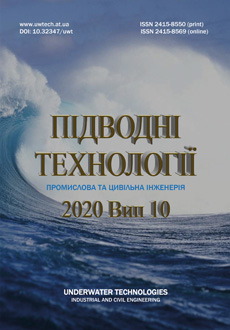The production of the splash phenomenon, as a way of dissipating the energy of a gravitational wave
DOI:
https://doi.org/10.32347/uwt2020.10.1802Ключові слова:
recreational zone, breakwater, wave transformation, energy dissipation, physical modeling, hydrodynamic benchАнотація
Investigations are aimed at revealing the conditions for the generation of a Splash wave phenomenon by a submerged breakwater, as having a particularly effective form of wave energy dissipation. On the basis of a wide range of well-known theoretical studies of wave transformation over bottom inhomogeneities, the expediency of laboratory experiments on physical models is shown as a method that allows taking into account the peculiarities of the influence of targeted turbolization of the water flow. Numerous experiments on physical models have shown the possibility of the occurrence of such a phenomenon over a system of bottom inhomogeneities and the rationality of further scientific search. However, the effect is achieved when certain parameters of many independent variables (significant and represented in a wide range of factors) are combined. This circumstance makes a positive solution of the problem rare in nature.
In view of the multifactority of the hydrodynamic process under investigation, an analysis of the theoretical premises was carried out, which allowed us to concentrate on a new variant of the solution of the problem posed – a single breakwater with a special crest design. The version of a "box" type breakwater was taken.as a basis But part of the wave energy quenched in it is directed to quenching another part of the energy of the wave flow passing over the top of the breakwater. The task was to find the location, shape and size of the opening in the top. Two versions were investigated: in the form of a perforation and in the form of a slit located along the breakwater. The last version showed its superiority and this result allowed to proceed to the solution of the next problem, the search for the most effective of the of the breakwater cavity cross-section.shape. The obvious direction of the search was the effect of a curvilinear wave-breaking wall of the embankment. Instead of the vertical face under the "visor" (that is, under the horizontal plane of the top surface) previously accepted in the studies, two schemes for calculating the surface curves, differing from each other in radius and length, are studied. The size of the slit in the "visor" varied. The conditions and prospects for the development of Recommendations for the design of the submerged breakwater of this type are described.
The urgency of the solution of the problem lies in the broad perspective of the use of submerged breakwaters in recreational zones.
Посилання
Udovik V.F., Mihajlichenko S.Yu., Goryachkin Yu.N., 2016. O vozmozhnom puti resheniya problemy zashity beregov. Sevastopol, Morskoj gidrofizicheskij zhurnal, No.2, 1-36 (in Russian).
Fokina N.A., 2008. Rekreacionnaya deyatelnost i abrazionnye processy. Simferopol, Stroitelstvo i tehnogennaya bezopasnost, Vyp.23, 88-92 (in Russian).
GOST 17.1.5.02-80. Ohrana prirody. Gidrosfera. Gigienicheskie trebovaniya k rekreacii vodnyh obektov. Moskva, Izdatelstvo standartov (in Russian).
Marugin V.M., Spiridonova M.A., 2013. Kvalimetriya morskih pribrezhnyh akvatorij, Sankt-Peterburg, Politehnika, 258 (in Russian).
Ivanenko T.A., Vetrova N.M., 2013. Kompleks ekologicheski bezopasnyh tehnicheskih reshenij zastrojki rekreacionnyh zon. Problemy ekologii, No.1, Doneck, DTNU, 89-97 (in Russian).
Volkova E.S., 2013. Razrabotka novogo metoda zashity iskusstvennyh territorij ot shtormovogo volneniya. Izvestiya Sochinskogo GU, №2, 7-10 (in Russian).
Savchenko V.E., 2018. Sovershenstvovanie konstrukcij beregoukrepitelnyh sooruzhenij. H Mezhdunarodnaya nauchnaya konferenciya Studencheskij nauchnyj forum – 2018, Rezhim dostupa: http//www.scinceforum.ru, 2 (in Russian).
Mak-Kormik, 1985. Preobrazovanie energii voln. Moskva, Energoizdat, 137 (in Russi-an).
Piterson V.D., 1962. Vetrovye volny. Sb. Vetrovye volny, Moskva, Izdatelstvo in-ostrannoj literatury, 561-583 (in Russian).
Longe-Higgins, 1962. Statisticheskij analiz sluchajnoj dvizhushejsya poverhnosti. Sb. Vetrovye volny. Moskva, Izdatelstvo in-ostrannoj literatury, 129-143 (in Russian).
Fillips O.M., 1980. Gidrodinamika poverhostnyh i vnutrennih voln. Leningrad, Gidrometizdat, 320 (in Russian).
Copyright certificate 1351988 USSR, 1987. Podvodnoe sooruzhenie, sposob ego montazha i demontazha. E.G. Gorbatenko. Byul.42, opubl. 15.11.1987 (in Russian).
Copyright certificate 1145087 USSR, 1985. Ustrojstvo dlya zashchity podvodnyh transhej ot zaneseniya nanosami. Gorbaten-ko E.G., Homickij V.V., Sokolnikov Yu.N., Kortikov I.A.. Byul.10, opubl. 15.03.1985 (in Russian).
Shujskij Yu.D., Vyhovanec G.V., 2017. Sovremennaya dinamika peschanyh akku-mulyativnyh form relefa v beregovoj zone Chyornogo morya. SlovakIntern. Scientific Journal (Bratislava), Vol.1, No.11, 22-32 (in Russian).
Gorbatenko E.G., Bratasyuk I.P., Sharov V.V., 2015. Mobilnye sooruzheniya v beregovoj gidrotehnike.Kiev,Podvodnye tehnologii, No.1, 23-32 (in Russian).
Chernyshov A.S., 2007. Ekonomiko-ekologicheskie aspekty ispolzovaniya pogruzhennyh dempfiruyushih platform pri stroitelstve gidrotehnicheskih sooruzhenij. Vesnik Odesskogo GU, Vyp.4, 113-121 (in Russian).
SP 277.13425800.2016, 2016. Sooru-zheniya morskie beregozashitnye. Pravila proektirovaniya. Moskva, Standartinform, 91 (in Russian).
Shahin V.M., Shahina T.V., 2000. Modelirovanie transformacii voln i techenij v pribrezhnoj zone morya.Moskva, Okeanologiya, Vol.40, No.5, 653-657 (in Russian).
Shelushinin Yu.A., Makarov K.N., 2019. Problemy i perspektivy gidravlicheskogo modelirovaniya volnovyh processov v iskazhyonnyh masshtabah. Stroitelstvo: nauka i obrazovanie, T.9, Vyp.2, 1-13 (in Russian).
Zommer V.L., 2015. Specifika gidravlicheskih i gidrotehnicheskih nauch-nyh issledovanij v laboratorii gidrotehniki i gidravliki. Stroitelstvo: nauka i obrazovanie, No.2, 5, Rezhim dostupa: http://nso-jornal.ru, 9 (in Russian).
Kushu, 2018. Problemy i osobennosti proektirovaniya i provedeniya ekspertiz morskih gidrotehnicheskih sooruzhenij. So-chi, Materialy H Mezhdunarodnoj nauchno-prakticheskoj konferencii, 21-23.05.2018, 12-17 (in Russian).
Shujskij Yu.D., 2018. Istoriya razvitiya i metodologiya beregovedeniya. Odessa, 456 (in Russian).
Shujskij Yu.D., Vihovanec G.V., Pank-ratenkova D.O., 2019. Osnovni risi antro-pogennogo vplivu v beregovij zoni Chor-nogo ta Azovskogo moriv u mezhah Ukraini. Sevastopol, Ukrainskij geografichnij zhurnal, No.1, 8-14 (in Russian).
##submission.downloads##
Опубліковано
Як цитувати
Номер
Розділ
Ліцензія

Ця робота ліцензується відповідно до Creative Commons Attribution 4.0 International License.
Автор(и) та Редакція згодні на те, що Редакція також матиме право:
- здійснювати необхідне оформлення Твору/Статті за результатами його редакційної обробки;
- визначати самостійно кількість видань, друк додаткових копій і тираж Твору/Статті, кількість копій окремих видань і додаткових тиражів;
- опублікування Твору/Статті в інших виданнях, пов’язаних з діяльністю Редакції

